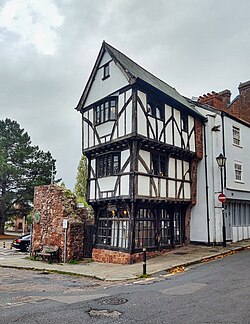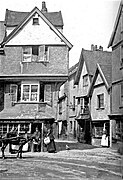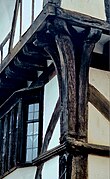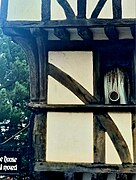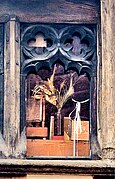317:
372:
333:
360:
345:
29:
305:
411:
477:
453:
267:, and had the West wall made of Heavitree stone. There was a single room on the ground floor and first floor, but two separate chambers on the second floor, with all floors being approximately equal height of around 7 feet 6 inches (229 cm) high. This pattern seems to have been popular in the city centre, especially on corner plots, although this is the only surviving example. At some point twin
460:
The building was in a poor state of repair and in order to move it, it was stripped back to just the wooden frame which still weighed 30 long tons (67,000 lb), which was then reinforced with a timber framework weighing a further 10 long tons (22,000 lb), which avoided using any metal screws
443:
intervened with a preservation order and a plan was put together to relocate the building in order that the road building could go ahead. Exeter City
Council was able to get a grant of £7,000 from the government (towards a total cost of over £8,000) to pay for a specialist London contractor to effect
464:
The move of the building began on
Saturday 9 December 1961, with the house being raised on jacks, and over the Sunday and Monday the house was slowly moved into the centre of Edmund Street. On Tuesday 12, Edmund Street was closed to traffic by the police, and the 70 metres (77 yd) move up the
506:
The reconstruction following the move did not replace the dormer windows in the cockloft, and also did not replace the later shopfront porch, and indeed moved the front door around the corner to the side which previously faced Frog Street and now faces West Street and the church.
237:
The house was built in the late Middle Ages, likely between 1420 and 1460, and was located at 16 Edmund Street, on the corner with Frog Street, probably for a wealthy merchant. This age makes it one of the oldest private dwellings in Devon, and may be one of the oldest in Europe.
461:
or bolts. Iron wheels were attached on the corners, and steel rails laid, and jacks were also added to ensure that the top-heavy house could be kept level during the move. The house was turned through 90 degrees to be in the right orientation for the move.
245:, and most of the currently visible old bridge was excavated during the demolition of Edmund and Frog Streets. The church on the bridge, the ruins of which are still clearly visible, including the tower, was St. Edmund's church, which was on Edmund Street.
431:
and subsequent post-war redevelopment in the area. Amongst similar buildings demolished was a similar age timber-framed building located on the site to where the house would eventually be moved to in the 1940s. The building was granted Grade II
422:
by 60 years or more) or the
Merchant House, and by now was in a very poor state of repair, local historians and archaeologists were keen to save the building, following the loss of a number of other historic buildings both during the
271:
were added to the cockloft, which can be seen in photographs of the building whilst at Edmund Street, as can a porch extension on front of the building with a shopfront. Photographs from that time also show the walls
472:
In order to ensure that the house stayed from falling over, spirit levels were used throughout the movement. The work started using two winches, but this ended up being too fast, and one winch was disconnected.
406:
allowing traffic to avoid the city centre when approaching the proposed two new bridges. The whole of Edmund Street and Frog Street were set to be demolished in order to make way for the road construction.
492:, adjacent to the former West Gate of the city walls. The move took about 4.5 hours. Once in place, the house was cemented down, and went through a full refurbishment, including extensive treatment for
316:
1170:
371:
414:
Oil painting showing the current location of the House that Moved in 1886, when the previous late Middle Ages building was still in-situ, prior to demolition in the 1940s
1081:
332:
344:
739:
120:
359:
304:
260:, which was a common feature at the time. The first floor overhangs by 1 foot 11 inches (58 cm) on two sides of the building.
1165:
1150:
953:
926:
681:
1175:
1054:
625:
1118:
842:
780:
1160:
1128:
936:
691:
440:
1064:
852:
790:
644:
825:
489:
481:
1099:
1036:
1018:
1000:
979:
890:
607:
547:
963:
765:
719:
444:
the move. In order to facilitate this, a compulsory purchase order was made on the building on 5 October 1960.
113:
806:
1155:
568:
1056:
A Jarrold guide to the
Cathedral and City of Exeter : with city centre map and illustrated walk
500:
257:
666:
218:
8:
520:
395:
283:
875:
911:
410:
1124:
1060:
959:
932:
848:
786:
715:
687:
214:
61:
608:"Highways Act 1959 and The Acquisition of Land (Authorisation Procedure) Act 1956"
433:
75:
488:
The house was brought into position at the bottom of West Street, opposite the
424:
351:
249:
242:
64:
28:
221:
in 1961 when the entire street it was on was demolished to make way for a new
1144:
466:
403:
273:
222:
135:
122:
476:
516:
428:
419:
241:
Edmund Street was previously the main road from Exeter's West Gate to the
418:
The building was known as the Tudor House (despite likely pre-dating the
323:
287:
626:"The story behind the 14th century house in Exeter that 'moved' in 1961"
548:"On the move after six hundred years: an ancient Exeter House's transit"
1082:"The House That Moved Exeter - The Shocking Story & How to Visit!"
456:
Map of the route of the move, showing the now demolished Edmund Street
399:
279:
Notable features of the house include one and two-light windows with
226:
493:
452:
378:
264:
253:
190:
310:
The house whilst at 16 Edmund Street, with dormers in the cockloft
280:
439:
The city council still wanted to demolish the building, but the
469:
hill was slowly completed using air-compressor driven winches.
268:
210:
98:
645:"The strange but true story of The House That Moved in Exeter"
326:
with curved vertical timbers supporting the first floor corner
290:
and curved headed posts which carry the projecting corners.
667:"The House That Moved, Exeter: History and visiting info!"
338:
Detail of curved timber supporting the corner of the house
377:
Close up of the original timbers, showing weathering and
1171:
Relocated buildings and structures in the United
Kingdom
225:
linked to the replacement of the city's bridge over the
398:
was planning the replacement of the bridge over the
515:The moving of the house was the setting for a 1978
807:"NO 24 WEST STREET, FORMERLY NO 16 EDMUND STREET"
778:
1142:
779:Allan, John; Alcock, Nat; Dawson, David (2015).
350:Tracery windows on the second floor featuring a
16:Historic building in Devon, South West England
705:
703:
827:Annual Report upon the School Health Service
712:Civil Engineering Heritage: Southern England
870:
868:
866:
864:
447:
258:projecting out further than the floor below
760:
758:
756:
754:
700:
365:First floor window with carved quatrefoils
176:30 long tons (67,000 lb) (frame only)
995:
993:
733:
731:
563:
561:
906:
904:
861:
830:. City and County of the City of Exeter.
584:
582:
580:
578:
475:
451:
409:
924:
888:
751:
683:125 years with the Western Morning News
679:
642:
588:
1143:
1079:
990:
951:
840:
823:
728:
664:
558:
263:It was built with three stories and a
901:
737:
575:
571:. National Heritage List for England.
542:
540:
510:
389:
1116:
1001:"A house moves-After Four Centuries"
844:A-Z of Exeter: Places-People-History
660:
658:
602:
600:
232:
912:"House That Moved. Exeter, England"
636:
13:
1166:Grade II listed buildings in Devon
1151:Buildings and structures in Exeter
878:. Exeter Memories. 10 August 2017.
747:. Exeter City Council. p. 31.
665:Martin, Claire (6 November 2022).
643:Parkman, Chloe (6 December 2020).
618:
537:
14:
1187:
1100:"Remarkable feat of transporting"
785:. Boydel and Brewer. p. 43.
782:West Country Households 1500-1700
709:
655:
597:
554:. 23 December 1961. p. 1109.
1176:Restored and conserved buildings
370:
358:
343:
331:
315:
303:
27:
1110:
1092:
1073:
1047:
1029:
1011:
972:
945:
918:
882:
834:
817:
799:
772:
480:The sign on the house with the
986:. 13 December 1961. p. 3.
766:"The House that Moved, Exeter"
673:
276:, with all the beams covered.
1:
1161:Tourist attractions in Exeter
1080:Pearce, Sophie (1 May 2023).
1037:"Tudor House Moved 100 Yards"
889:Hoskins, WG (17 March 1960).
530:
499:The move was praised by the
402:, and the construction of a
7:
1019:"Moving House-In One Piece"
200:180 square feet (17 m)
10:
1192:
928:Exeter: cathedral and city
213:, originally built in the
209:is a historic building in
501:National Buildings Record
196:
185:
180:
172:
167:
159:
151:
112:
104:
94:
81:
70:
57:
52:
42:
38:
26:
21:
980:"Moving Day-For a House"
811:Archaeology Data Service
503:as a "remarkable feat".
448:Movement of the building
847:. Amberley Publishing.
738:Brown, Stewart (2010).
680:Mildren, James (1985).
591:Exeter houses 1400-1700
552:Illustrated London News
490:Church of St Mary Steps
482:Church of St Mary Steps
295:Original house features
925:Thurmer, John (1985).
876:"The House that Moved"
841:Hallam, Chris (2019).
741:The Exe Bridge, Exeter
485:
457:
415:
1041:Birmingham Daily Post
952:Meller, Hugh (1989).
479:
455:
413:
1120:The House that Moved
1117:Rees, David (1978).
1059:. 1998. p. 17.
1023:Liverpool Daily Post
525:The House that Moved
519:children's story by
436:on 29 January 1953.
286:heads, and diagonal
207:The House That Moved
152:Estimated completion
136:50.71977°N 3.53479°W
33:The House That Moved
22:The House That Moved
1086:Third Eye Traveller
1043:. 13 December 1961.
1025:. 13 December 1961.
1007:. 13 December 1961.
955:Exeter architecture
824:Irvine, ED (1964).
589:Portman, D (1966).
396:Exeter City Council
322:Detail of diagonal
132: /
58:Architectural style
53:General information
768:. Britain Express.
632:. 16 January 2023.
614:. 20 October 1960.
511:In popular culture
486:
458:
416:
390:Planned demolition
252:, with each floor
141:50.71977; -3.53479
46:The Merchant House
1156:History of Exeter
1130:978-0-14-031256-0
1106:. 2 January 1963.
938:978-0-7117-0188-5
693:978-0-948158-02-5
593:. pp. 73–74.
569:"24, West Street"
441:Ministry of Works
233:Original building
204:
203:
181:Technical details
1183:
1135:
1134:
1123:. Puffin Books.
1114:
1108:
1107:
1104:Express and Echo
1096:
1090:
1089:
1077:
1071:
1070:
1051:
1045:
1044:
1033:
1027:
1026:
1015:
1009:
1008:
997:
988:
987:
976:
970:
969:
949:
943:
942:
922:
916:
915:
914:. Atlas Obscura.
908:
899:
898:
895:Express and Echo
886:
880:
879:
872:
859:
858:
838:
832:
831:
821:
815:
814:
803:
797:
796:
776:
770:
769:
762:
749:
748:
746:
735:
726:
725:
707:
698:
697:
677:
671:
670:
669:. Go South West.
662:
653:
652:
640:
634:
633:
622:
616:
615:
612:Express and Echo
604:
595:
594:
586:
573:
572:
565:
556:
555:
544:
374:
362:
347:
335:
319:
307:
215:late Middle Ages
147:
146:
144:
143:
142:
137:
133:
130:
129:
128:
125:
90:16 Edmund Street
62:Late Middle Ages
31:
19:
18:
1191:
1190:
1186:
1185:
1184:
1182:
1181:
1180:
1141:
1140:
1139:
1138:
1131:
1115:
1111:
1098:
1097:
1093:
1078:
1074:
1067:
1053:
1052:
1048:
1035:
1034:
1030:
1017:
1016:
1012:
999:
998:
991:
978:
977:
973:
966:
950:
946:
939:
923:
919:
910:
909:
902:
891:"Typical House"
887:
883:
874:
873:
862:
855:
839:
835:
822:
818:
805:
804:
800:
793:
777:
773:
764:
763:
752:
744:
736:
729:
722:
708:
701:
694:
686:. p. 103.
678:
674:
663:
656:
641:
637:
624:
623:
619:
606:
605:
598:
587:
576:
567:
566:
559:
546:
545:
538:
533:
513:
450:
392:
387:
386:
385:
382:
375:
366:
363:
354:
348:
339:
336:
327:
320:
311:
308:
297:
296:
235:
140:
138:
134:
131:
126:
123:
121:
119:
118:
86:
76:listed building
48:The Tudor House
47:
34:
17:
12:
11:
5:
1189:
1179:
1178:
1173:
1168:
1163:
1158:
1153:
1137:
1136:
1129:
1109:
1091:
1072:
1065:
1046:
1028:
1010:
989:
971:
964:
944:
937:
917:
900:
881:
860:
853:
833:
816:
798:
791:
771:
750:
727:
720:
714:. p. 73.
699:
692:
672:
654:
635:
617:
596:
574:
557:
535:
534:
532:
529:
512:
509:
449:
446:
425:Baedeker raids
394:In the 1950s,
391:
388:
384:
383:
376:
369:
367:
364:
357:
355:
352:multifoil arch
349:
342:
340:
337:
330:
328:
321:
314:
312:
309:
302:
299:
298:
294:
293:
292:
243:Old Exe Bridge
234:
231:
202:
201:
198:
194:
193:
187:
183:
182:
178:
177:
174:
170:
169:
165:
164:
161:
157:
156:
153:
149:
148:
116:
110:
109:
108:United Kingdom
106:
102:
101:
96:
92:
91:
85:24 West Street
83:
79:
78:
72:
71:Classification
68:
67:
59:
55:
54:
50:
49:
44:
40:
39:
36:
35:
32:
24:
23:
15:
9:
6:
4:
3:
2:
1188:
1177:
1174:
1172:
1169:
1167:
1164:
1162:
1159:
1157:
1154:
1152:
1149:
1148:
1146:
1132:
1126:
1122:
1121:
1113:
1105:
1101:
1095:
1087:
1083:
1076:
1068:
1066:9780711710047
1062:
1058:
1057:
1050:
1042:
1038:
1032:
1024:
1020:
1014:
1006:
1002:
996:
994:
985:
981:
975:
967:
961:
957:
956:
948:
940:
934:
930:
929:
921:
913:
907:
905:
896:
892:
885:
877:
871:
869:
867:
865:
856:
854:9781445689654
850:
846:
845:
837:
829:
828:
820:
812:
808:
802:
794:
792:9781843839941
788:
784:
783:
775:
767:
761:
759:
757:
755:
743:
742:
734:
732:
723:
717:
713:
706:
704:
695:
689:
685:
684:
676:
668:
661:
659:
650:
646:
639:
631:
627:
621:
613:
609:
603:
601:
592:
585:
583:
581:
579:
570:
564:
562:
553:
549:
543:
541:
536:
528:
526:
522:
518:
508:
504:
502:
497:
495:
491:
483:
478:
474:
470:
468:
462:
454:
445:
442:
437:
435:
434:listed status
430:
426:
421:
412:
408:
405:
401:
397:
380:
373:
368:
361:
356:
353:
346:
341:
334:
329:
325:
318:
313:
306:
301:
300:
291:
289:
285:
282:
277:
275:
270:
266:
261:
259:
255:
251:
250:half-timbered
248:The house is
246:
244:
239:
230:
228:
224:
220:
216:
212:
208:
199:
195:
192:
188:
184:
179:
175:
171:
166:
163:December 1961
162:
158:
154:
150:
145:
117:
115:
111:
107:
103:
100:
97:
93:
89:
84:
80:
77:
73:
69:
66:
65:Half-timbered
63:
60:
56:
51:
45:
41:
37:
30:
25:
20:
1119:
1112:
1103:
1094:
1085:
1075:
1055:
1049:
1040:
1031:
1022:
1013:
1005:Daily Herald
1004:
984:Daily Mirror
983:
974:
954:
947:
927:
920:
894:
884:
843:
836:
826:
819:
810:
801:
781:
774:
740:
711:
682:
675:
648:
638:
629:
620:
611:
590:
551:
524:
517:Puffin Books
514:
505:
498:
487:
471:
463:
459:
438:
429:World War II
420:Tudor period
417:
393:
288:dragon beams
278:
262:
247:
240:
236:
206:
205:
95:Town or city
87:
43:Former names
710:Otter, RA.
404:bypass road
324:dragon beam
223:bypass road
186:Floor count
139: /
114:Coordinates
1145:Categories
965:0850336937
721:0727719718
649:Devon Live
531:References
521:David Rees
284:cinquefoil
197:Floor area
168:Dimensions
124:50°43′11″N
400:River Exe
281:traceried
227:River Exe
219:relocated
160:Relocated
127:3°32′05″W
74:Grade II
630:ITV News
494:woodworm
484:opposite
467:gradient
379:woodworm
274:rendered
265:cockloft
191:cockloft
88:Formerly
523:called
269:dormers
254:jettied
105:Country
82:Address
1127:
1063:
962:
935:
851:
789:
718:
690:
211:Exeter
173:Weight
99:Exeter
745:(PDF)
465:1:10
381:holes
1125:ISBN
1061:ISBN
960:ISBN
933:ISBN
849:ISBN
787:ISBN
716:ISBN
688:ISBN
256:and
217:and
189:3 +
155:1450
427:of
1147::
1102:.
1084:.
1039:.
1021:.
1003:.
992:^
982:.
958:.
931:.
903:^
893:.
863:^
809:.
753:^
730:^
702:^
657:^
647:.
628:.
610:.
599:^
577:^
560:^
550:.
539:^
527:.
496:.
229:.
1133:.
1088:.
1069:.
968:.
941:.
897:.
857:.
813:.
795:.
724:.
696:.
651:.
Text is available under the Creative Commons Attribution-ShareAlike License. Additional terms may apply.
